Intel Ghost Canyon NUC9i9QNX Review: NUC 9 Extreme Realizes the SFF Dream
by Ganesh T S on April 16, 2020 8:05 AM ESTBAPCo SYSmark 2018
The Intel NUC9i9QNX (Ghost Canyon) was evaluated using our Fall 2018 test suite for small-form factor PCs. In the first section, we will be looking at SYSmark 2018.
BAPCo's SYSmark 2018 is an application-based benchmark that uses real-world applications to replay usage patterns of business users in the areas of productivity, creativity, and responsiveness. The 'Productivity Scenario' covers office-centric activities including word processing, spreadsheet usage, financial analysis, software development, application installation, file compression, and e-mail management. The 'Creativity Scenario' represents media-centric activities such as digital photo processing, AI and ML for face recognition in photos and videos for the purpose of content creation, etc. The 'Responsiveness Scenario' evaluates the ability of the system to react in a quick manner to user inputs in areas such as application and file launches, web browsing, and multi-tasking.
Scores are meant to be compared against a reference desktop (the SYSmark 2018 calibration system, a Dell Optiplex 5050 tower with a Core i3-7100 and 4GB of DDR4-2133 memory to go with a 128GB M.2 SATA III SSD). The calibration system scores 1000 in each of the scenarios. A score of, say, 2000, would imply that the system under test is twice as fast as the reference system.
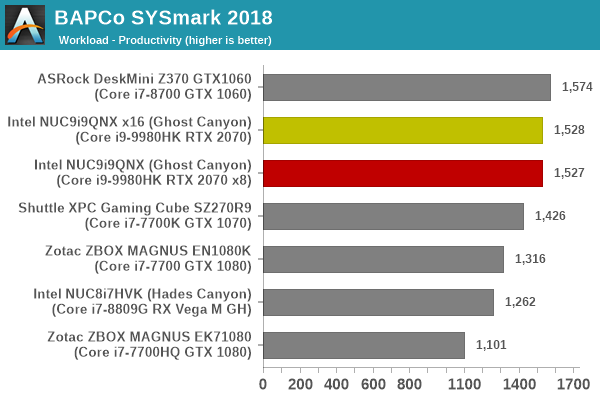
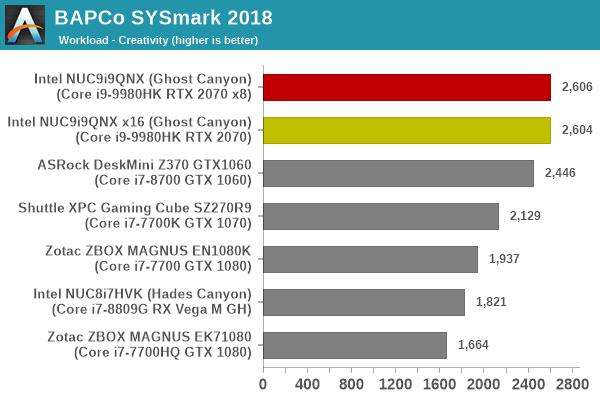
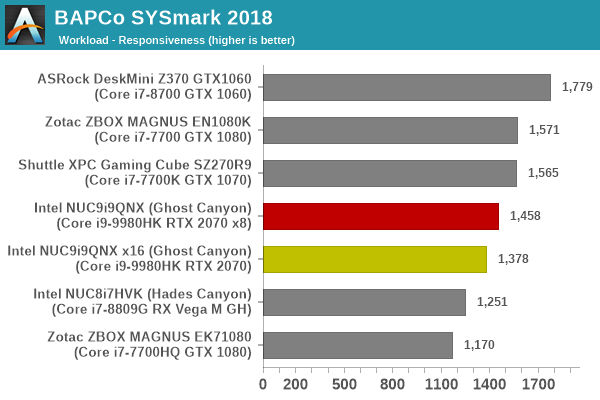
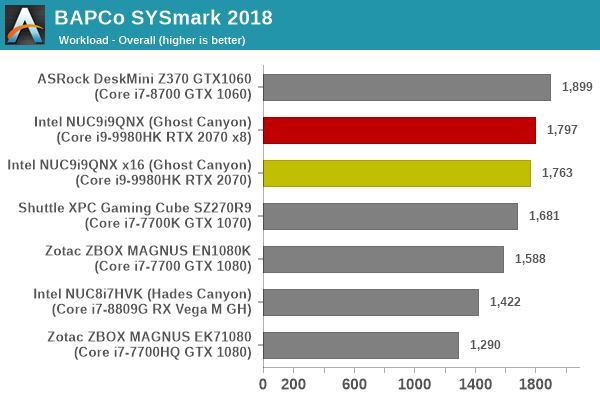
Systems equipped with 65W+ TDP desktop processors get higher scores in most workloads, though only the DeskMini Z370 manages an higher overall rating compared to the NUC9i9QNX. The surprising result is the responsiveness score for the two Ghost Canyon configurations - having the Optane drive talk directly to the CPU without the DMI bottleneck makes the system significantly more responsive.
SYSmark 2018 also adds energy measurement to the mix. A high score in the SYSmark benchmarks might be nice to have, but, potential customers also need to determine the balance between power consumption and the efficiency of the system. For example, in the average office scenario, it might not be worth purchasing a noisy and power-hungry PC just because it ends up with a 2000 score in the SYSmark 2014 SE benchmarks. In order to provide a balanced perspective, SYSmark 2018 also allows vendors and decision makers to track the energy consumption during each workload. In the graphs below, we find the total energy consumed by the PC under test for a single iteration of each SYSmark 2018 workload. For reference, the calibration system consumes 5.36 Wh for productivity, 7.71 Wh for creativity, 5.61 Wh for responsiveness, and 18.68 Wh overall.

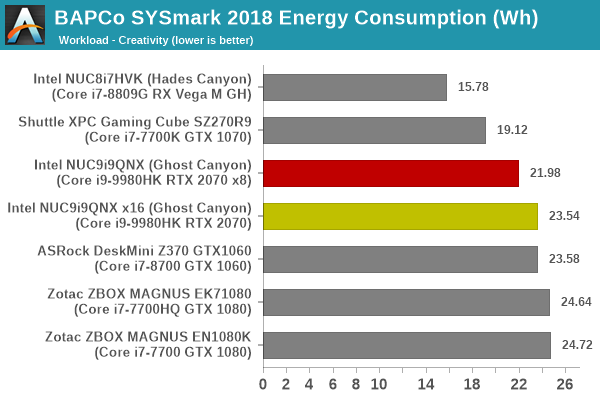
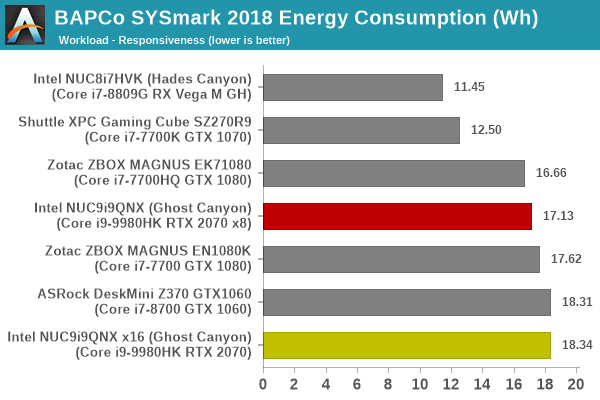
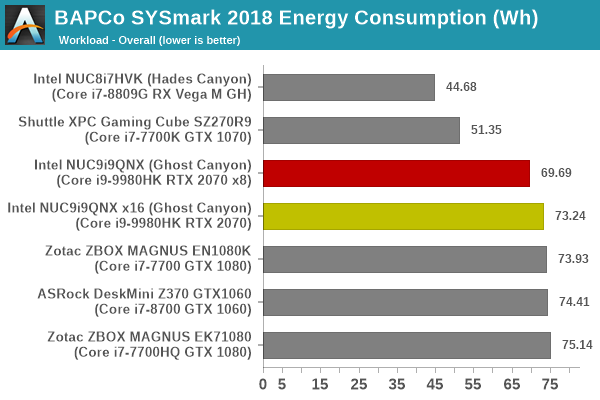
The NUC9i9QNX is hobbled slightly by the power-hungry Optane drive and high-TDP discrete GPU, making it approach the other desktop CPU-based systems in the list when the overall energy consumption is considered. Compared to a x16 configuration, operating the GPU at x8 results in lowered energy consumption for the SYSmark 2018 workloads.










109 Comments
View All Comments
ganeshts - Monday, April 20, 2020 - link
The review of the ASRock 4x4 box based on that *single* reference design will be out soon. It targets the *embedded* market, and you will soon see why that is so. Currently, AMD's PC division (i.e, non-embedded) doesn't seem to think of mini-PCs as a high-margin area worth concentrating on. There is a reason why Udoo Bolt uses embedded Ryzen. And, that is why ASRock and other *embedded* market-targeting companies have those Zen 1 products.Spunjji - Friday, April 24, 2020 - link
"OEMs can take the plunge only if the silicon vendors offer them a proof of concept."This really doesn't strike me as the least bit true. Sure, a reference design would help - but it's surely not essential?
ganeshts - Friday, April 24, 2020 - link
In every silicon vendor offering marketing I have seen (as an industry observer visiting trade shows, and as an engineer working in a fabless semiconductor company), there exists a board in a form-factor very *similar* to the end product that the vendor is targeting - either created by the vendor themselves, or, an ODM with close ties that is led hand-in-hand by the vendor [ eg. Thundersoft does the reference design implementation of Snapdragon IP cameras for Qualcomm - https://www.qualcomm.com/news/onq/2016/02/05/snapd... , and the ODM was funded in part by Qualcomm Ventures - https://www.qualcommventures.com/companies/mobile/... ].I would be very interested in knowing whether there are any examples for what you are suggesting - where a product was created for the end market without a reference design from main silicon's vendor.
bug77 - Thursday, April 16, 2020 - link
I stopped reading when I got to the price.zer0hour - Thursday, April 16, 2020 - link
+1quadrivial - Thursday, April 16, 2020 - link
A mitx board is 6.75 x 6.75 inches. The final dimensions for this machine are around 9.5 x 8.5 inches.$1000-1700 without GPU, SSD, RAM is ridiculous for a mitx system. You could build an good (complete) system just a fraction bigger for that same price.
bug77 - Friday, April 17, 2020 - link
Or, if you need something small, you can get a similarly specced laptop.Namisecond - Friday, April 17, 2020 - link
Exactly. Sliger even offers a case with a similar kind of PCIe splitter as this NUC offers. Even in the business space, how is this machine going to compete against those @9 Liter Dell, HP, Lenovo SFF workstations at half the price?shabby - Thursday, April 16, 2020 - link
+100 😂sorten - Thursday, April 16, 2020 - link
+1Stunned by the price. $2800 for a last generation CPU, 16GB of RAM, and an RTX 2070? Wow.